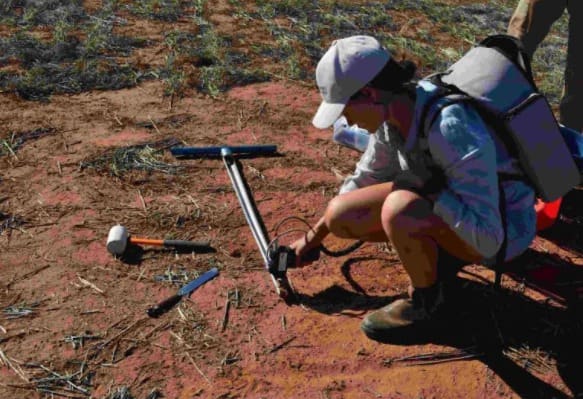
PhD student Ruby Hume’s research is investigating in-field spectral assessment of soils using infrared spectroscopy technology.
A SIMPLE inexpensive and fast method to measure low concentrations of lime in soil will be tested on South Australian farms over the next two years.
The new method to detect and measure carbonate in soils using Mid Infrared (MIR) spectroscopy was developed by University of Adelaide scientists. It also has potential for measuring soil carbon and other properties.
PhD student and lead author of the study Ruby Hume, developed the method as part of a Department of Primary Industries and Regions (PIRSA)-led and Grains Research and Development Corporation-funded project, exploring novel approaches to address the issue of sub-surface soil acidification in South Australia’s cropping regions.
Lime (calcium carbonate) is typically applied on farms to treat soil acidity. To maximise its effectiveness, it is important to understand how the lime dissolves and moves through the soils. Another big issue is the development of acid layers below the soil surface, which are difficult to detect and treat.
Ms Hume is now applying the new method in a number of field trials, set to run until the end of 2023. The lime research is published in leading soil science journal Geoderma.
She said it was hoped the new method would enable quicker assessment of the impact of lime applications, but it might not be ready for on-farm use for some years.
“At the moment we have tested this in the lab with samples that we’ve spiked,” she said.

PhD student Ruby Hume soil sampling at one of the PIRSA acid soils trial sites established to explore soil acidity management approaches.
The new method has raised the prospect of in-field scanning of samples, potentially bringing the timeframe from sampling to results back to minutes rather than up to an hour using current methods.
Ms Hume said the method is being tested at field trial sites on South Australian farms to see if the movement and effectiveness of lime applications through the soil profile can be detected and traced.
She said the cost and time required with current testing methods is limiting soil lime assessments on farms. The concentrations of lime in acidic soils can also be so low as to be difficult to detect in commercial laboratories.
“Lots of commercial lambs can’t actually get down to those levels that are relevant for this application.
“So this offers an alternative that in many cases isn’t achievable in a commercial lab.”
The field trials have been established by the Grain Research and Development Corporation’s Acid Soils SA team. They will involve different liming treatments and incorporation methods with other organic amendments to see which are more effective and how they move to sub-surface layers, Ms Hume said.
Ms Hume said soil acidity can be very damaging to crop production.
“Approximately 20 percent of agricultural land in South Australia is affected by the problem, and this number is expected to double over the next few decades.
“While it is not a new problem in South Australia, we are now seeing acidity in regions where it has not been an issue previously, such as in the mid-north and the Yorke Peninsula, and clay-rich soils in the south-east.”
MIR spectroscopy is a relatively well-established tool in soil chemistry that measures the vibrations of molecular bonds within the soil when infrared light is shined on a sample.
“With this technology we were able to detect very small amounts of lime that might get lost amongst the other information that is contained in the soil,” Ms Hume said.
“It is a valuable tool as it is accurate, inexpensive and requires minimal sample preparation.”
Co-author and Principal PhD Supervisor Associate Professor Luke Mosley from the University of Adelaide’s Environment Institute and School of Biological Sciences said the researchers hoped to be able to detect lime products through the soil profile and measure if and how they move through the soil to treat acidity effectively.
“The method is also potentially useful for soil carbon storage projects, which are increasingly being implemented in Australia and globally as a way to help mitigate climate change.”
New method has soil carbon and climate change potential
In future research, Ms Hume plans to look at plant spectral responses to acidity and liming, and has been awarded an Australian Plant Phenomics Facility (APPF) postgraduate internship to explore this with a potted trial at the APPF’s Smart House facility, beginning next year.



HAVE YOUR SAY